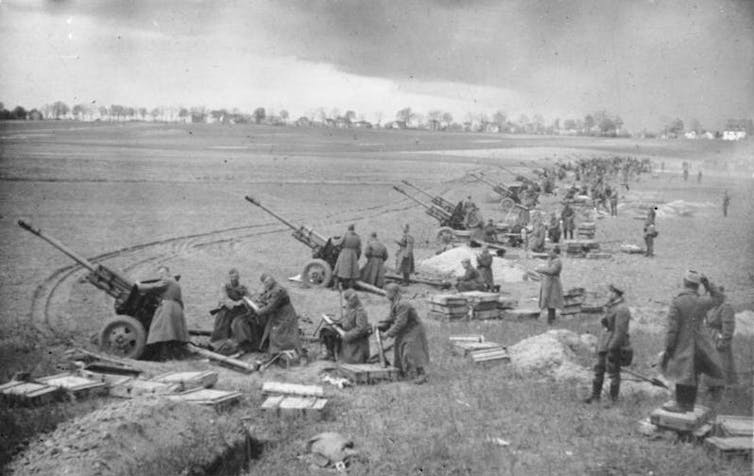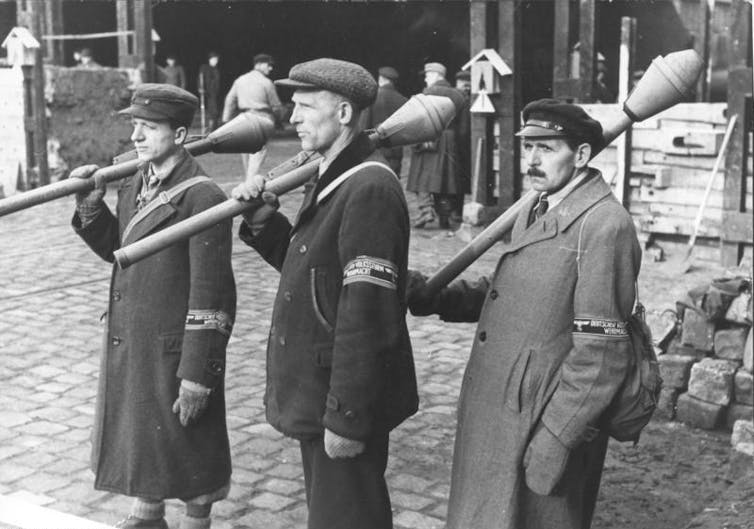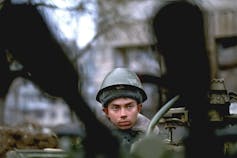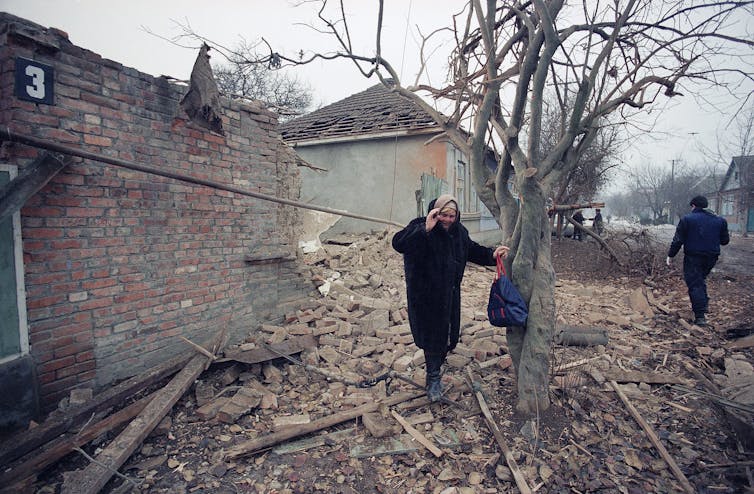The Conversation
March 23, 2022

Ukraine (Aris Messinis/Agence France-Presse)
Vladimir Putin had clearly hoped his invasion of Ukraine would be over quickly and not involve prolonged fighting for large cities.
Putin and other Russian leaders know well the high cost of fighting for cities, both from Soviet and recent Russian history. While there is talk of a peace deal — and Putin could be looking for a face-saving exit strategy — the fighting still continues and Russian attacks on civilians are intensifying.
As the battle to capture Berlin during the Second World War and more recent fighting for the Chechen capital of Grozny in both 1994-1995 and 1999-2000 show, fighting for urban areas generally leads to high casualties among combatants and civilians alike.
Fighting over cities is also slow. In light of Russia’s experience with this type of warfare and the ferocity of Ukrainian resistance, neither Putin nor his generals were probably expecting quick results in Ukraine.
To take cities like Kyiv or Kharkiv without suffering unsustainable casualties, Russian forces will have to continue to make widespread use of artillery — something Soviet leader Joseph Stalin once described as “the God of War.”
During the Second World War, artillery typically involved unguided munitions fired from either guns, howitzers or rocket launchers. Today, artillery also includes firing munitions that are guided, but the cheapest form of artillery remains the unguided shell or rocket.

Soviet artillery bombards German positions during the early stages
of the operation to capture Berlin in April 1945.
(Deutsch Bundesarchiv Bild), CC BY
(Deutsch Bundesarchiv Bild), CC BY
Soviet experience
Russian forces have a long history of capturing cities after heavy fighting. Perhaps the most famous example is the capture of Berlin by the Red Army in May 1945 after two weeks of fighting.
The widespread use of artillery was crucial to keeping Red Army losses down against German defenders who were at times fanatical. Whole blocks of the German capital were levelled by both artillery and bombing by Soviet aircraft. Nonetheless, the Red Army still took horrendous casualties capturing the heart of the Third Reich — nearly 80,000 were killed.
Soviet tanks had a role to play in the capture of Berlin, but by the end of the Second World War, tanks were extremely vulnerable to recently developed infantry anti-tank weapons such as the German Panzerfaust.

Militia men in Berlin hold Panzerfausts.
(Deutshe Bundesarchiv Bild), CC BY
During the final phases of fighting for Berlin, one Soviet commander had to bang on the side of Soviet tanks to rouse tank crews inside and encourage them to move forward when they were unwilling to advance towards the Reichstag building in the city centre. In front of those young tank crews stood three burnt-out tanks, a testament to the dangers posed to tanks operating in urban environments.
Casualties among senior Russian commanders in Ukraine suggest that they, too, have had to lead from the front in order to motivate their troops.
Second Chechen war
After the collapse of the Soviet Union in 1991, Chechen separatists wanted to leave the Russian Federation. But Russian leader Boris Yeltsin had just overseen the collapse of the U.S.S.R. and wasn’t about to allow what was technically part of Russia to leave.
The fighting for the Chechen capital Grozny in late 1994 and early 1995 was a stark reminder for Russian forces of how difficult it is to fight for urban areas.

In this 1995 photo, a young Russian soldier keeps watch from his anti-aircraft gun position in Grozny, Russia.
(AP Photo/Alexander Zemlianichenko)
Russian troops suffered heavy casualties against a stubborn defence. After an initial attempt to seize the city, the Russian army subsequently had to regroup and engage in a much more systematic destruction of enemy resistance, making widespread use of artillery and air power.
Civilian casualties were high — as many as 27,000 people were killed. The Russian army would officially acknowledge the deaths of 1,376 Russian soldiers in fighting for the city, with another 408 missing.

Chechen citizens look over the rubble of destroyed houses
during a lull in the fighting in Grozny in January 1995.
(AP Photo/Mindaugas Kulbis, File)
During the second Chechen war in 1999-2000 — with Vladimir Putin in charge — Russian troops had learned their lesson from the first. Rather than trying to rush the city’s defenders, Russian forces took a more systematic approach.
Russian artillery and air power systematically pounded the city before Russian ground forces fought well-prepared defenders block-by-block. A corridor for civilians to flee the besieged city was established, but it was dangerous and many chose to stay.
It still took Russian forces more than a month to capture the city of Grozny during the second Chechen war — and even then, they faced guerrilla warfare after they had done so.
(AP Photo/Mindaugas Kulbis, File)
During the second Chechen war in 1999-2000 — with Vladimir Putin in charge — Russian troops had learned their lesson from the first. Rather than trying to rush the city’s defenders, Russian forces took a more systematic approach.
Russian artillery and air power systematically pounded the city before Russian ground forces fought well-prepared defenders block-by-block. A corridor for civilians to flee the besieged city was established, but it was dangerous and many chose to stay.
It still took Russian forces more than a month to capture the city of Grozny during the second Chechen war — and even then, they faced guerrilla warfare after they had done so.
The war in Ukraine
Logistically, the Russian army wasn’t prepared for a long war when it invaded Ukraine. The Russian army also didn’t expect to have to use the artillery assets that are now being employed against cities like Kharkiv.
Russia started to use its artillery when it became clear the war wasn’t going well, but doing so nonetheless plays to the Russian army’s strength in artillery.
Stubborn Ukraine defenders — well-equipped with anti-tank and anti-aircraft weapons from the West — are proving to be difficult to root out from urban areas. To send Russian infantry and tanks into cities without first “suppressing” or “neutralizing” defences, as attacking defenders is known in military jargon, would no doubt lead to unacceptable losses for Russian tanks and infantry.
With Russian aircraft vulnerable to western-supplied anti-aircraft weapons, this leaves Russian artillery. Stalin’s God of War is now, in many ways, the principal Russian weapon in Ukraine.

A self-propelled Russian howitzer, an example
of Russian artillery, during practices for the 2014 Victory Day parade.
(Vitaly V. Kuzmin), CC BY
In practice, conventional artillery is indiscriminate. Russian forces are therefore resorting to the indiscriminate artillery-oriented strategy that was used to subdue Grozny and will be difficult for Ukrainian forces to counter.
Russian commanders are no doubt aware that it takes time to conquer a well-defended city. They do, however, have the advantage of a recent historical precedent in Grozny for eventually “winning” against an entrenched defender in an urban environment. Still, the key coastal city of Mariupol has been under siege for weeks and has still not been captured.

A mother embraces her son who escaped the besieged city
(Vitaly V. Kuzmin), CC BY
In practice, conventional artillery is indiscriminate. Russian forces are therefore resorting to the indiscriminate artillery-oriented strategy that was used to subdue Grozny and will be difficult for Ukrainian forces to counter.
Russian commanders are no doubt aware that it takes time to conquer a well-defended city. They do, however, have the advantage of a recent historical precedent in Grozny for eventually “winning” against an entrenched defender in an urban environment. Still, the key coastal city of Mariupol has been under siege for weeks and has still not been captured.

A mother embraces her son who escaped the besieged city
of Mariupol and arrived at the train station in Lviv, western
Ukraine on March 20, 2022.
(AP Photo/Bernat Armangue)
Whether Russian society is willing to accept the sort of Russian losses that will likely result from capturing Kyiv, and other major Ukrainian cities, remains to be seen. The cracks are already appearing in Russia, but there is probably still a long way to go before Putin feels he has to make peace on less than desirable terms and lose face.
Sadly, the bloodshed could continue for some time. If it does, many more soldiers and civilians alike will be killed and maimed amid the hell of what is essentially old-school urban warfare.
Alexander Hill, Professor of Military History, University of Calgary
This article is republished from The Conversation under a Creative Commons license. Read the original article.
(AP Photo/Bernat Armangue)
Whether Russian society is willing to accept the sort of Russian losses that will likely result from capturing Kyiv, and other major Ukrainian cities, remains to be seen. The cracks are already appearing in Russia, but there is probably still a long way to go before Putin feels he has to make peace on less than desirable terms and lose face.
Sadly, the bloodshed could continue for some time. If it does, many more soldiers and civilians alike will be killed and maimed amid the hell of what is essentially old-school urban warfare.

Alexander Hill, Professor of Military History, University of Calgary
This article is republished from The Conversation under a Creative Commons license. Read the original article.
No comments:
Post a Comment